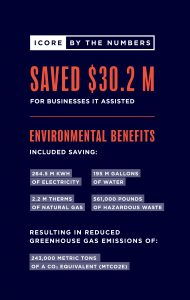 ISTC’s technical assistance program engineers have been awarded a $338,549 pollution prevention (P2) grant from U.S. EPA Region 5 to provide on-site pollution prevention technical assistance, including Economy, Energy and Environment (E3), to Illinois food and beverage manufacturers and processors. This assistance will result in reduced water and energy usage, hazardous materials generation, and reduce business costs.
ISTC’s technical assistance program engineers have been awarded a $338,549 pollution prevention (P2) grant from U.S. EPA Region 5 to provide on-site pollution prevention technical assistance, including Economy, Energy and Environment (E3), to Illinois food and beverage manufacturers and processors. This assistance will result in reduced water and energy usage, hazardous materials generation, and reduce business costs.
This grant is part of the ongoing Illinois Conservation of Resources and Energy (ICORE) project.
Principal investigator Dan Marsch says, “Since its inception, ICORE has been a very successful program providing on-site P2 technical assistance to businesses in underserved communities across Illinois. ICORE is one of U.S. EPA Region 5’s flagship programs, delivering consistent results and leadership in sustainability within the region.”
Food and beverage manufacturers, processing facilities, and their direct suppliers and supporting industries are all eligible for assistance under through this project. Interested companies may contact:
Northern Illinois
Shantanu Pai
(630) 586-9168
spai@illinois.edu
Central Illinois
Troy Walker
(217) 300-1596
twalk@illinois.edu
Southern Illinois
Dan Marsch
(217) 300-4199
djmarsch@illinois.edu

